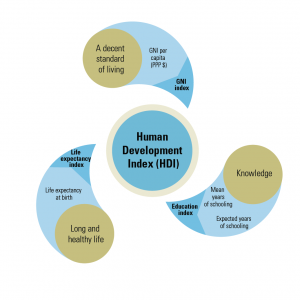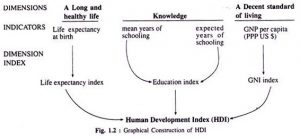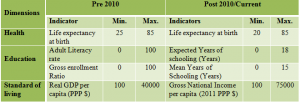
Human Development Index (HDI)
- Human Development Index (HDI) is a composite measure of health, education and income
- Human Development Index was developed by a Pakistani economist and later adopted by United Nations
 Development Program (UNDP) as a measure to assess the social and economic development of a country
Development Program (UNDP) as a measure to assess the social and economic development of a country - It was developed as an alternative measure to the economic assessment of a nation for determining the national progress
- HDI is a comprehensive and holistic measure of human development than per capita income alone
- The major objective behind HDI is to assess three dimensions and components of development and well-being i.e. health, education and living standard
- HDI can also be used to discuss and finalize the policy choices between the nations as countries with approximately same GDP
- The value of HDI ranges from minimum 0 to maximum1.
- 0 represents the least marking i.e. maximum distance remaining to reach to a higher level of development while 1 represents the maximum/highest marking i.e. least distance remaining to reach to a higher level of development
- HDI includes three dimensions:
- Health/longevity:
 Life expectancy at birth
Life expectancy at birth
- Education/knowledge:
- Mean years of schooling
- Expected Years of Schooling and
- Income: Gross National Income (GNI) per capita (in purchasing power parity (PPP) in US dollars)
- For all these three dimensions of HDI, there is a fixed set of minimum and maximum values which are called goalposts. Score obtained by the countries in each dimensions are used to see where the country stands in relation to the goalposts.
- It is necessary to know that there have been some changes in calculation of HDI since 2010. Since, 2010 UNDP has made some changes in the indicators as well as their minimum and maximum values as well.
- For each indicator, there is a fixed set of minimum and maximum value established. On the basis of these values, indexes are constructed.
- Figure below shows the differences and similarities among the indicators and their values in Pre 2010 and Post 2010 era.

- Based on the minimum and maximum values, individual indices can be calculated as:
Index= (Actual Value) – (Minimum Value) / (Maximum Value) – (Minimum Value)
| Based on the above informations, calculation of each indexes can be done as:
• Life Expectancy Index (LEI) = Actual LE – 20/(85-20) • Income Index (II) = {ln(GNI pc)- ln(100)}/{ln(75,000) – ln(100)} • Education Index (EI) = MYSI+EYSI / 2 • Mean Years of Schooling Index (MYSI) = MYS-0 / 15-0 • Expected Years of Schooling Index (EYSI) = EYS-0 / 18-0 Now, HDI is the geometric mean of previous three indices i.e. HDI= |
| Note:
Mean Year of Schooling (MYS)– Years that a 25 year old person or older has spent in schools Expected Years of Schooling (EYS):- Years that a 5 year old child will spend with his education in his whole life |
- The new measure of HDI is different in a way that the old measure was the linear average of three dimensions while the new HDI measure is a geometric mean approach which ensures uniformity and penalizes skewed and unbalanced development across different dimensions
- The HDI score of each country shows human development status of that country. The cut-off point of HDI and their classification (as per UNDP report 2016) is as such:

Limitations of HDI:
- HDI does not focus on other key human related issues like inequality, poverty, human safety and security and empowerment. Countries with high GNI may also have high inequality and poor safety and security. Eg: Saudi Arabia
- HDI looks as a country whole. So, in case of big countries like China and Kenya HDI score varies widely depending on the region of the country, which cannot be seen clearly by HDI
- HDI shows long term changes (eg: life expectancy). Thus, immediate and short term changes are neglected
- HDI also misses many other indicators for economic development of a nation such as pollution, access to clean and safe drinking water, sanitation etc
- Though HDI holds current level of social and economic development of a nation, it does not give any information regarding the future developmental prospects/scopes
References
http://hdr.undp.org/sites/default/files/hdr2016_technical_notes_0.pdf
https://www.slideshare.net/arslan_bzu/human-development-index-27698915
http://hdr.undp.org/en/content/human-development-index-hdi
http://www.investopedia.com/terms/h/human-development-index-hdi.asp
http://www.measureofamerica.org/human-development/
http://www.diva-portal.org/smash/get/diva2:464378/FULLTEXT03
http://economictimes.indiatimes.com/definition/human-development-index
http://www.economicshelp.org/blog/glossary/human-development-index/
http://scholarworks.umass.edu/cgi/viewcontent.cgi?article=1101&context=peri_workingpapers
http://www.oecd.org/site/progresskorea/44110008.pdf
http://www.globalpolitics.cz/clanky/human-development-index-how-to-cope-with-its-limitations
https://www.ophi.org.uk/wp-content/uploads/Noorbakhsh.pdf
http://www.igidr.ac.in/pdf/publication/WP-2013-020.pdf
http://onlinelibrary.wiley.com/doi/10.1002/jid.3380050210/abstract
http://etheses.lse.ac.uk/2499/1/U615448.pdf
https://link.springer.com/article/10.1023/A%3A1006839208067
http://mhhdc.org/wp-content/themes/mhdc/reports/Kh%20speech%20for%20Foreign%20Service%20Academy.pdf
http://www.eui.eu/Research/Library/ResearchGuides/Economics/Statistics/DataPortal/HDR.aspx
http://www.nationmaster.com/country-info/stats/Economy/Human-Development-Index
http://www.businessdictionary.com/definition/human-development-index-HDI.html
http://ec.europa.eu/eurostat/statistics-explained/index.php/Glossary:Human_development_index_(HDI)